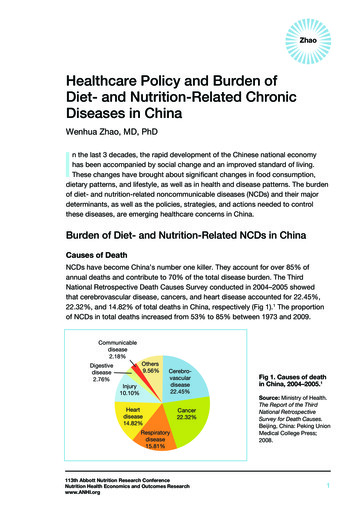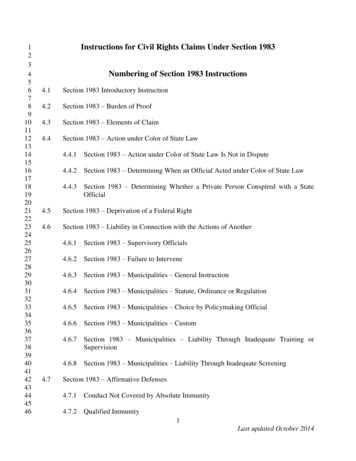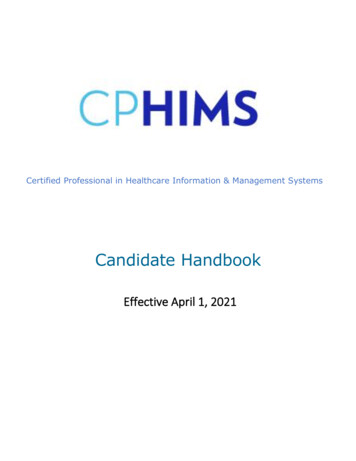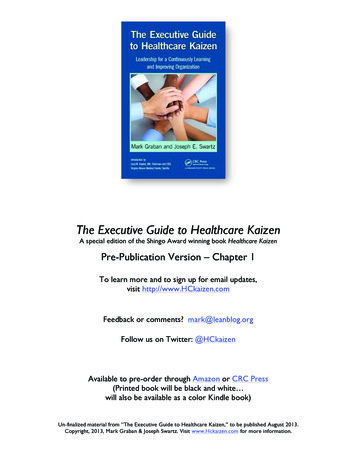
Transcription
ZhaoHealthcare Policy and Burden ofDiet- and Nutrition-Related ChronicDiseases in ChinaWenhua Zhao, MD, PhDIn the last 3 decades, the rapid development of the Chinese national economyhas been accompanied by social change and an improved standard of living.These changes have brought about significant changes in food consumption,dietary patterns, and lifestyle, as well as in health and disease patterns. The burdenof diet- and nutrition-related noncommunicable diseases (NCDs) and their majordeterminants, as well as the policies, strategies, and actions needed to controlthese diseases, are emerging healthcare concerns in China.Burden of Diet- and Nutrition-Related NCDs in ChinaCauses of DeathNCDs have become China’s number one killer. They account for over 85% ofannual deaths and contribute to 70% of the total disease burden. The ThirdNational Retrospective Death Causes Survey conducted in 2004–2005 showedthat cerebrovascular disease, cancers, and heart disease accounted for 22.45%,22.32%, and 14.82% of total deaths in China, respectively (Fig 1).1 The proportionof NCDs in total deaths increased from 53% to 85% between 1973 and 5.81%113th Abbott Nutrition Research ConferenceNutrition Health Economics and Outcomes Researchwww.ANHI.orgFig 1. Causes of deathin China, 2004–2005.1Source: Ministry of Health.The Report of the ThirdNational RetrospectiveSurvey for Death Causes.Beijing, China: Peking UnionMedical College Press;2008.1
Healthcare Policy and Burden of Dietand Nutrition-Related Chronic Diseases in ChinaPrevalenceHypertension. Hypertension is one of the most important diseases and themost important risk factor for stroke and other cardiovascular disease in China.According to three national hypertension epidemiology surveys conducted in 1959,1979, and 1991, and the 2002 China National Nutrition and Health Survey,2 thecrude prevalence of hypertension in China among people aged 15 years and olderincreased from 5.11% in 1959 to 17.65% in 2002. The prevalence of hypertensionamong Chinese adults aged 18 and older reached 33.5% in 2010. It is estimatedthat 200 million Chinese adults had hypertension in 2012.Type 2 diabetes. The prevalence of type 2 diabetes in China in the 1980s was only0.8%. However, the 2002 national survey showed that the national prevalence oftype 2 diabetes has reached 2.6% and was much higher (6.1%) in large cities.3According to the 2010 China Chronic Disease Surveillance results, the prevalenceof diabetes among Chinese adults aged 18 years and above was 9.7% (Fig 2).49.7% of Chinese aged 18 yearsand above with T2D10864.764202.952.60.819801989199620022010Fig 2. Increase in prevalence of type 2 diabetes in China, 1980–2010.3,4T2D type 2 diabetesSources: 2002 China Health and Nutrition Survey. Available at http://www.cpc.unc.edu/projects/china/data. Accessed October 15, 2012. 2010 China Behavioral Risk Factor Surveillance System. Available athttp://www.chinacdc.cn. Accessed October 15, 2012.2113th Abbott Nutrition Research ConferenceNutrition Health Economics and Outcomes Researchwww.ANHI.org
ZhaoOverweight and obesity. The prevalence of overweight and obesity has increasedsignificantly over the last decade. In 2002, 22.8% of Chinese adults wereoverweight and 7.1% were obese.3 During the decade between 1992 and 2002,the overweight rate in adults increased by 40.7% and the obesity rate increased by97.2%. According to the China Chronic Disease Surveillance data, the prevalenceof overweight among adults aged 18–69 years was 23.1% in 2004, 27.3% in 2007,and 28.6% in 2010, and the obesity rate was 7.2% in 2004, 8.0% in 2007, and12.0% in 2010.4 At the same time, the prevalence of overweight and obesity amongChinese children and adolescents also increased rapidly, especially in large cities.Economic BurdenIn 2009, on average, the cost of hospital admission for a typical NCD patient was50% of the disposable annual income of an urban resident (5176.9 RMB [Renminbi,or yuan], or 750 USD [US Dollars], per capita per year), and 1.3 times that of a ruralresident (2009 RMB, or 291 USD, per capita per year).5 The highest cost was fora coronary artery bypass operation, which was 1.2 times higher than the annualdisposable income of an urban resident, and 6.4 times higher than the net annualincome of a rural resident. The total medical cost caused by NCDs in China was1.48 trillion RMB (210 billion USD) in 2005. The proportion of the NCD diseaseburden increased from 54% in 1993 to 63% in 2005. According to the Report onDisease Burden Research published by the World Health Organization in 2009,NCDs accounted for nearly 69% of the total of disease economic burden in China.6The total medical cost attributable to overweight and obesity was estimated at21.11 billion yuan (RMB) in China in 2002, accounting for 25.5% of the total medicalcosts for the four chronic diseases, or 3.7% of national total medical costs in 2003.7The direct costs of hypertension, diabetes, coronary heart disease, and strokesattributable to overweight and obesity were 37.4%, 34.2%, 11.3%, and 23.3% in2002, respectively.Major DeterminantsDiet and nutrition transition. The dietary pattern of Chinese people has undergonedramatic changes since the 1950s, especially in the last 3 decades. Four nationalnutrition and health surveys have been conducted in China since 1959. The second,carried out in 1982, showed that the nutritional status of the Chinese populationwas greatly improved as compared with the data in the 1950s. The third, conductedin 1992, showed that the main features of the dietary transition are a decrease in113th Abbott Nutrition Research ConferenceNutrition Health Economics and Outcomes Researchwww.ANHI.org3
Healthcare Policy and Burden of Dietand Nutrition-Related Chronic Diseases in Chinagrain and carbohydrate intake and an increase in meat, poultry, fish, and edibleoil/fat intake (Fig 3).3,8 The trend toward westernization of the Chinese diet is quiteobvious, although the current average diet is still plant-based.CerealsMeat & poultry, fishesOther cerealWheat flourRice 4021722321821725645100242260200100Meat & 982 1992 20021982 1992 2002UrbanRural019821992 2002Urban1982 19922002Rural*g/reference man/dFig 3. Changes in patterns of food consumption in urban and rural China, 1982–2002.3Source: 2002 China National Nutrition and Health Survey. Available at http://www.cpc.unc.edu/projects/china/data. Accessed October 15, 2012.The fourth survey, which was conducted in 2002, showed that the main features ofthe dietary transition are several significant changes in the dietary pattern: Dietary fat intake was close to 30% of total dietary energy intake. These dataindicate that the diet of urban Chinese is imbalanced, and the diet of ruralChinese is getting better compared with the Chinese dietary guidelines. The consumption of edible oil is increasing significantly. The national averageconsumption of edible oil in 1982, 1992, 2002 and 2010 was 18.0, 29.5, 41.6,and 49.1 g/capita/day, respectively.3,4High salt intake is a traditional dietary habit among both urban and rural Chinese.Average daily salt intake for a reference man in 1982, 1992, and 2002 was12.7, 13.9, and 12.0 g/day, respectively.3 This is approximately twice the levelrecommended by Chinese dietary guidelines.4113th Abbott Nutrition Research ConferenceNutrition Health Economics and Outcomes Researchwww.ANHI.org
ZhaoPhysical activity. Increasing urbanization and industrialization are associatedwith a dramatic decrease in physical activity level, and lifestyles of the Chinesein general have become more sedentary, as indicated by the low percentage ofChinese people exercising regularly. In 2007, less than 12% of Chinese aged16 years and older undertook regular exercise three times a week for 30 minutes.9Since the 1990s, the number of private cars has increased by more than 40 times,contributing to the decrease in physical activity.Healthcare, Nutritional Improvement, and NCD ControlPolicies, Strategies, and Actions in ChinaPolicies and StrategiesChina’s government is committed to meeting the challenges of NCDs and improvingthe nutritional status of the Chinese people. Several policies and strategies havebeen established: Increasing life expectancy by 1 year was set as one of the major goals ofthe 12th Five-Year Plan (2011–2015) for National Economic and SocialDevelopment. The Compendium for Food and Nutrition Development in China (2001–2010)was issued by the General Office of the State Council in 2001. China National NCDs Control and Prevention Plan (2012–2015) was launchedMay 30, 2012, and it was jointly signed by 15 Ministries. The Chinese Health Reform, started in 2009, identified five key reformtasks for 2009–2011: the establishment of a basic health insurance system,establishment of a basic national medicine system, improvement of thegrassroots healthcare service system, accelerated equalization of primaryhealthcare services, and enhancement of the trial reform of public hospitals.ActionsIn 2007, The National Action on Healthy Lifestyle for All was initiated by theMinistry of Health. The first phase of the campaign was focused on balanced dietand physical activity. By 2010, the campaign had expanded to all 31 provinces inMainland China and was set as an important platform for health promotion. TheProject on Path to Health, which aims to establish exercise facilities in communitiesacross the country, was initiated by the General Administration of Sports, China, in2000. Sustainable funding of 40 million USD annually was provided by the ChineseSports Lottery Fund.113th Abbott Nutrition Research ConferenceNutrition Health Economics and Outcomes Researchwww.ANHI.org5
Healthcare Policy and Burden of Dietand Nutrition-Related Chronic Diseases in ChinaTechnical guidelines have been established, including Chinese Guidelines onAdult Obesity Control and Prevention, Chinese Guidelines on Childhood ObesityControl and Prevention, Chinese Dietary Guidelines and Chinese Food Pagoda,Chinese Guidelines for Hypertension Control and Prevention, Chinese Guidelines forDiabetes Control and Prevention, and Chinese Guidelines on Adult Physical Activity.These guidelines, developed by related scientific societies, mostly have been issuedby the Ministry of Health.Providing health management services for patients with hypertension or diabeteshas been given high priority. By the end of March, 2011, the number of patientsunder standardized disease management reached 42 million with hypertension and11 million with diabetes.9Conclusion and a Perspective on Nutrition Improvementand NCD Control in ChinaChina’s NCD epidemic will continue to explode over the next 20 years if notaddressed effectively. Much of the diet- and nutrition-related NCD burden can beavoided and controlled by the adoption of good practices that have been proveneffective internationally, and their adaptation to local conditions. By reducingunhealthy behaviors and improving nutritional status through balanced diets andincreased physical activity, by improving socioeconomic environments conduciveto health, and by expanding access to quality healthcare services, people will notonly live longer, but their quality of life will improve due to the reduction of chronicdisease and disability at the end of life.AcknowledgementThis research uses data from the China Health and Nutrition Survey (CHNS). Wethank the National Institute of Nutrition and Food Safety, China Center for DiseaseControl and Prevention; the Carolina Population Center, University of North Carolinaat Chapel Hill; the National Institutes of Health (NIH; R01-HD30880, DK056350, andR01-HD38700); and the Fogarty International Center, NIH, for financial support forthe CHNS data collection and analysis files since 1989. We thank those parties, theChina-Japan Friendship Hospital, and the Ministry of Health for support for CHNS2009 and future surveys.6113th Abbott Nutrition Research ConferenceNutrition Health Economics and Outcomes Researchwww.ANHI.org
ZhaoReferences1. Ministry of Health. The Report of the Third National Retrospective Survey forDeath Causes. Beijing, China: Peking Union Medical College Press; 2008.2. Wu Y, Huxley R, Li L. Prevalence, awareness, treatment, and control ofhypertension in China: data from the China National Nutrition and Health Survey2002. Circulation. 2008 Dec;118(25):2679-2686.3. 2002 China National Nutrition and Health Survey. Available at http://www.cpc.unc.edu/projects/china/data. Accessed October 15, 2012.4. Chinese Center for Disease Control and Prevention, 2011. Summary of 2010China Chronic Disease and Behavior Risk Factor Surveillance. Available athttp://www.chinacdc.cn. Accessed October 15, 2012.5. Ministry of Health, 2010. China Health Statistic Yearbook. Ministry of Health,Beijing, China. Available at http://www.moh.gov.cn. Accessed October 15,2012.6. World Health Organization. Report on Disease Burden Research. Geneva,Switzerland; 2009.7. Zhao W, Zhai Y, Hu J, et al. Economic burden of obesity-related chronicdiseases in Mainland China. Obes Rev. 2008 Mar;9(suppl 1):62-67.8. 1992 China Health and Nutrition Survey. Available at http://www.cpc.unc.edu/projects/china/data. Accessed October 15, 2012.9. Bureau of Disease Prevention and Control, Ministry of Health, Chinese Centerfor Disease Control and Prevention. Report on Non-Communicable Disease inChina. Ministry of Health; Beijing, China; 2011.113th Abbott Nutrition Research ConferenceNutrition Health Economics and Outcomes Researchwww.ANHI.org7
Nutrition Health Economics and Outcomes Research www.ANHI.org 1 Healthcare Policy and Burden of Diet- and Nutrition-Related Chronic Diseases in China Wenhua Zhao, MD, PhD I n the last 3 decad










